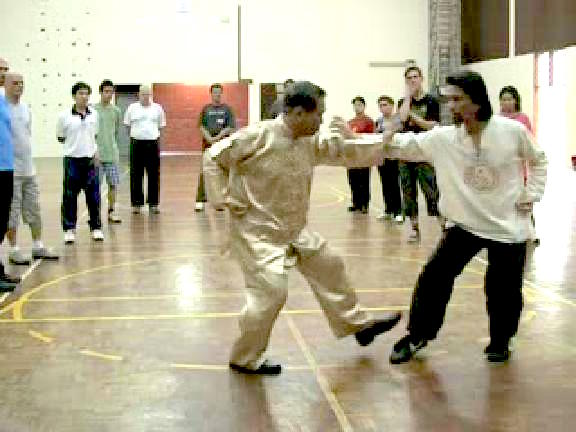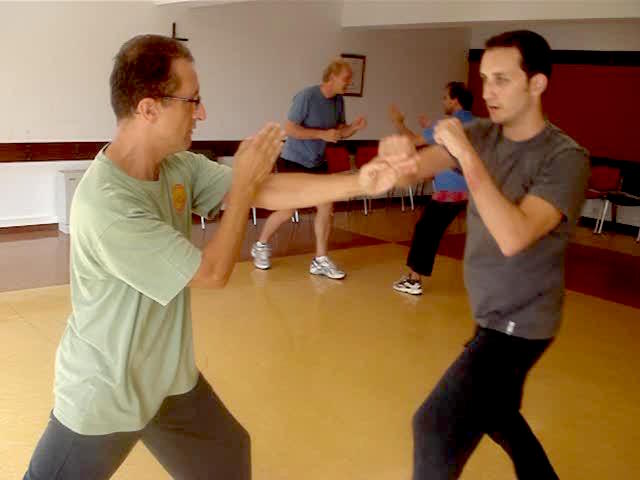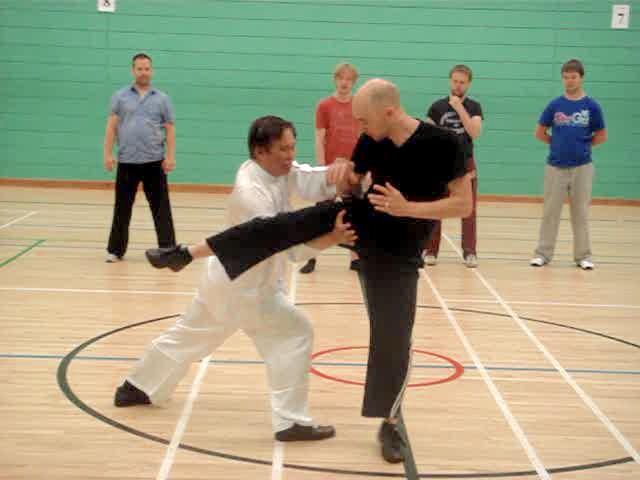IS IT NECESSARY TO ATTEND SPECIAL COURSES?

Course participants at a special Wing Choon course developing the special skill of being able to deflect attacks without looking at them.
With the offering of many courses recently, some students may wonder whether we have deviated from the original aim of our school. Of course, we haven't. In fact the offering of these courses is a fulfillment of our original aim.
What is the original aim of establishing Shaolin Wahnam? It is to preserve and pass on to deserving students all over the world irrespective of race, culture and religion the wonderful Shaolin arts (including Taijiquan of course). Hence, offering the various special courses like Wing Choon, Iron Wire and Praying Mantis, which represent some of the best Shaolin arts, is contributing towards this aim.
Why are these arts only taught now, and not earlier? In other words, as I have a huge collection of these Shaolin arts, why don't they form the core of our Shaolin Wahnam syllabuses, instead our basic teachings are the 16 combat sequences, or 12 in the case of Taijiquan?
The answer is straight-forward and touches on our unique teaching methodology. If you learn classical kungfu sets straight-away using traditional methods, like what I myself followed, it would take you at least ten to fifteen years before you could be competent in using kungfu patterns for combat and be able to develop internal force, that is if you are lucky to learn from a genuine master. It would take you another fifteen to twenty years, if you have the determination and perseverance, to become a genuine kungfu master where sparring with masters of other martial arts would be relatively easy.
But with our unique teaching methodology, applying our 16 or 12 combat sequences and the relaxation approach of stance training, we can shorten the training time by at least a third! In three years you have remarkable internal force and can competently use kungfu patterns to spar. In ten years you can spar comfortably with masters of other martial arts.
To help you further in combat efficiency, I have worked out a series of effective techniques and tactics against other marital arts. Please see Shaolin Kungfu against Other Martial Arts and Wahnam Taijiquan against Other Martial Arts. As these are recent innovations in our teaching methodology, they are not yet included in our basic syllabuses. Your instructors will find ways to introduce them into their teaching.

The basic 16 Shaolin Combat Sequences (or 12 Taijiquan Combat Sequences) are sufficient to meet all combat situations
A question many students may have is whether the many new special courses interfere with their basic training? No, they will not. These special courses are a continuation of -- not a replacement for -- your basic training. Actually they are meant for instructors and advanced students who are already well versed in the basic combat sequences, but as I may not offer them again, we also accept other students.
Will training sophisticated combat applications from the special courses detract from training basic combat sequences, or vice versa? No, on the contrary, they enhance each other. In other words, because you also train sophisticated combat applications, your attainment in the basic combat sequences will be better, and vice versa.
Let us take the combat applications in Shaolin Kungfu against Other Martial Arts and the 16 Basic Shaolin Combat Sequences, and the 18 best techniques and tactics of the time in the Eighteen-Collection Set of Praying Mantis Kungfu as an illustration. They represent the lowest, the intermediate and the advanced level respectively in combat training.
If you just practice the 16 Basic Shaolin Combat Sequences which form the core of our combat training (or the 12 Basic Taijqiaun Combat Sequences for Taijiquan students) without learning any other combat applications you can be quite proficient in your friendly sparring or real fighting. Irrespective of whether your opponent is a low-level Boxer or a high-level master using sophisticated techniques, the 16 or 12 combat sequences are more than adequate in handling any combat situations.
However, as some of you have experienced, when meeting opponents of other martial arts, you may have some difficulty adjusting to ways of fighting different from those of Shaolin Kungfu. Wouldn't it be great if someone who has much fighting experience and knowledge helps you to choose the most appropriate techniques and tactics to meet these different fighting styles? This is exactly what happens in Shaolin Kungfu against Other Martial Arts.
If your opponents are also proficient in sparring, you will have to find more sophisticated techniques and tactics other than those in the 16 basic combat sequences to beat them. With the training and understanding of the basic sequences, you can work out more sophisticated techniques and tactics on your own. But you will not only save much time but also have better results if you can learn from and use the best techniques and tactics of past masters. This is exactly what happens in the Eighteen-Collection Set.
On the other hand, if you just stick with Shaolin Kungfu against Other Martial Arts, the lowest level in our combat training programme, you will only be efficient against opponents who use low-level techniques. If you meet opponents who use sophisticated techniques, you may not know what to do.

You may like a short-cut to find out some appropriate Shaolin or Taijiquan techniques and tactics against other martial arts
Reversely, if you start with sophisticated patterns like those in the Eighteen-Collection Set, you may end up with just performing beautiful patterns but not being able to apply the patterns in sparring, even when your opponents use low-level techniques like straight-forward punches and kicks. This is actually what has happened to the majority of kungfu practitioners today.
The same applies to internal force training. Our basic kungfu programme is more than enough to provide for all our needs in internal force training, ranging from the lowest level of maintaining well-being to the highest level of spiritual fulfillment.
If a student is sick, he can overcome his sickness through his Shaolin Kungfu practice, like generating a chi flow after some stance training. But it would be more cost-effective to use a lower-level method like exercises from the Eighteen Lohan Hands.
If he wishes to use his internal force to enhance his daily work, he can also achieve that through his Shaolin Kungfu practice. But it will be more cost-effective if he uses the form-flow-force approach, or the flow method, learnt in one of the special courses.
A question that may bother some students is that spending time and effort for the special courses, or for Shaolin Kungfu against Other Martial Arts, would take away time and effort they could spend for their basic training. They have to make some time adjustment.
Let us take a very rough analogy of a bicycle, a motorcycle and a car. If your main mode of transport is a motorcycle, learning how to ride a bicycle and drive a car will take some time and effort from your motorcycling. You have to make some time adjustment, but it is worthwhile. You may not need a bicycle or a car if you already have a motorcycle, but there are certainly occasions where a bicycle or a car is more useful.
The special courses as well as the innovation in Shaolin Kungfu against Other Martial Arts are not compulsory in our syllabuses, though the special courses will bring you to a higher stage where our school is now moving to. If you are happy with the basic syllabus, that is fine. If you wish to take advantage of the opportunities offered, the opportunities are here in our school.

You may need sophisticated techniques, like those learnt in special courses, to defeat advanced opponents
